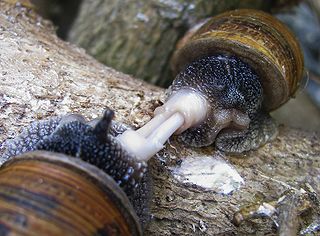
Gastropods, commonly known as slugs and snails, belong to a large taxonomic class of invertebrates within the phylum Mollusca called Gastropoda.

Nudibranchs are a group of soft-bodied marine gastropod molluscs that shed their shells after their larval stage. They are noted for their often extraordinary colours and striking forms, and they have been given colourful nicknames to match, such as "clown", "marigold", "splendid", "dancer", "dragon", and "sea rabbit". Currently, about 3,000 valid species of nudibranchs are known.

Sea slug is a common name for some marine invertebrates with varying levels of resemblance to terrestrial slugs. Most creatures known as sea slugs are gastropods, i.e. they are sea snails that over evolutionary time have either completely lost their shells, or have seemingly lost their shells due to having a greatly reduced or internal shell. The name "sea slug" is most often applied to nudibranchs, as well as to a paraphyletic set of other marine gastropods without obvious shells.

Opisthobranchs is a now informal name for a large and diverse group of specialized complex gastropods which used to be united in the subclass Opisthobranchia. That taxon is no longer considered to represent a monophyletic grouping.

Prosobranchia was a large taxonomic subclass of sea snails, land snails and freshwater snails. This taxon of gastropods dates back to the 1920s. It has however been proven to be polyphyletic. Generally speaking in biology taxonomy is required to reflect phylogeny, in other words the classification of a group must reflect its evolutionary descent, as far as that is known, so the taxon Prosobranchia is no longer considered suitable to be used.

Heterobranchia, the heterobranchs, is a taxonomic clade of snails and slugs, which includes marine, aquatic and terrestrial gastropod mollusks.

The order Cephalaspidea, also known as the headshield slugs and bubble snails, is a major taxon of sea slugs and bubble snails, marine gastropod mollusks within the larger clade Euopisthobranchia. Bubble shells is another common name for these families of marine gastropods, some of which have thin bubble-like shells. This clade contains more than 600 species.

Haminoeoidea is a taxonomic superfamily of small sea snails or bubble shells, marine opisthobranch gastropod mollusks in the clade Cephalaspidea, the headshield slugs and bubble snails.

Navanax inermis, common name the California aglaja, is a large species of predatory sea slug, a marine opisthobranch gastropod mollusk in the family Aglajidae. Navanax is not a nudibranch, even though it somewhat resembles one; it belongs to a more ancient lineage of opisthobranchs called the cephalaspideans or head shield slugs and snails.

A land snail is any of the numerous species of snail that live on land, as opposed to the sea snails and freshwater snails. Land snail is the common name for terrestrial gastropod mollusks that have shells. However, it is not always easy to say which species are terrestrial, because some are more or less amphibious between land and fresh water, and others are relatively amphibious between land and salt water.

A rhinophore is one of a pair of chemosensory club-shaped, rod-shaped or ear-like structures which are the most prominent part of the external head anatomy in sea slugs, marine gastropod opisthobranch mollusks such as the nudibranchs, sea hares (Aplysiomorpha), and sap-sucking sea slugs (Sacoglossa).

Chrysomallon squamiferum, commonly known as the scaly-foot gastropod, scaly-foot snail, sea pangolin, or volcano snail is a species of deep-sea hydrothermal-vent snail, a marine gastropod mollusc in the family Peltospiridae. This vent-endemic gastropod is known only from deep-sea hydrothermal vents in the Indian Ocean, where it has been found at depths of about 2,400–2,900 m (1.5–1.8 mi). C. squamiferum differs greatly from other deep-sea gastropods, even the closely related neomphalines. In 2019, it was declared endangered on the IUCN Red List, the first species to be listed as such due to risks from deep-sea mining of its vent habitat.

Hydatina physis is a species of sea snail, a bubble snail, a marine opisthobranch gastropod mollusk in the family Aplustridae. Its common names include striped paper bubble, green-lined paper bubble, brown-lined paper bubble, and rose petal bubble shell.

In anatomy, an eyestalk is a protrusion that extends an eye away from the body, giving the eye a better field of view. It is a common feature in nature and frequently appears in fiction.

The nervous system of gastropods consists of a series of paired ganglia connected by major nerve cords, and a number of smaller branching nerves. It is sometimes called ganglionic.
Bathynerita is a genus of sea snails, marine gastropod mollusks in the family Neritidae.

Bathymodiolus childressi is a species of deepwater mussel, a marine bivalve mollusk species in the family Mytilidae, the mussels.

Hancock's organ is a lateral concealed sensory organ of gastropods, a chemo-sensory sense organ found in some sea snails. This organ is found in most of the shelled opisthobranchs.

The mating of gastropods is a vast and varied topic, because the taxonomic class Gastropoda is very large and diverse, a group comprising sea snails and sea slugs, freshwater snails and land snails and slugs. Gastropods are second only to the class Insecta in terms of total number of species. Some gastropods have separate sexes, others are hermaphroditic. Some hermaphroditic groups have simultaneous hermaphroditism, whereas some sequential hermaphroditism. In addition, numerous very different mating strategies are used within different taxa.
This outline is provided as an overview of, and organized list of articles relevant to, the subject of gastropods :
































